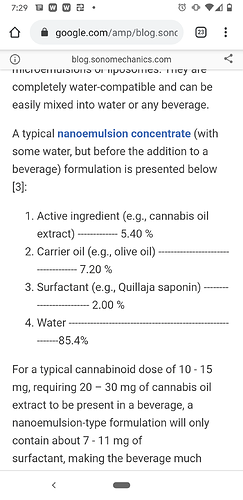First test:
3% Distillate
4% Jojoba Oil
32% Q-Naturale
61% Water
Second test (doubled the water content, all else the same):
1.5% Distillate
2% Jojoba Oil
16% Q-Naturale
80.5% Water
FisherSci Model 705 (Same as Qsonica Q700)
85% Amplitude
1/2 Tip
12-20 min sonication time, pulse mode.
Far from stable. Anybody had better luck with Axiomm’s uGoo?
1 Like
Why did you choose to use Jojoba oil?
2 Likes
You mention percents, but how big are your batches? How many grams of each ingredient?
1 Like
What frequency and amplitude? (Amplitudes are not percentages, that’s just a percentage of your units max)
Also, make sure your oil is fully winterized. You could start with isolate to see if the distillate is your problem.
Try this formulation from Sonomechanics
1 Like
-
Jojoba oil because I had planned to formulate a topical. From what I read jojoba absorbs easier into skin. This may or may not be true.
-
Test one was 165ml. Test two was 330ml. So let’s say 5ml of Distillate, 6ml of Jojoba. The sonicator is only putting out 65 watts to drive the probe. Should be well within range? 
-
The FisherSci Model 705 is 20hz. Amplitude I’m not sure, whatever 85% is?
-
The distillate is winterized. I had the original crude oil processed myself.
Thanks for the IS formula. They’re using 12.6% oil and 2% Quillaja Extract. This is 6:1 on the oil side. Ingredion (makers of Q-Naturale) state that their maximum suggested ratio is 4:1.
It’s worth remembering that Q-Naturale is only 14% saponins, so a 20ml sample has only 2.8ml of actual emulsifier.
Is this just way too high of an oil load or do I need more emulsifier?
Ebook_MAKING_STABLE_EMULSIONS.pdf (2.1 MB)
I highly recommend this E-book. If I were you I would start by making a formulation of things that are known to work (i.e. Soybean oil as carrier, isolate, good ratio of tween and span as shown in the e-book) and then start substituting in the components you are wanting until it doesn’t work so you can isolate what’s causing problems for you. From my experiance with nanoemulsions your formulation looks good, although I haven’t used Jojoba, is it medium chain, long chain?
As it shows on the e-book, you will have a much easier time with as high an amplitude you can get to, hopefully over 80 microns, and with a tweakable ratio of a tween and a span to optimize for your oil.
2 Likes
Sonication doesn’t result in a very narrow polydispersity index of your nanoparticles and as a result the emulsion isn’t stable. Unless you’ve got a cryo flow cell or a covaris your emulsions won’t be very stable. With a sonotrode horn everything from tip depth and consistency in placement to container shape and volume will affect the particle size reduction capabilities. Any outliers in particle size will cause your emulsion to tend toward floccuation or coalescence. So as much as the ratios matter for tuning particle size, the high energy input methodology is extremely important to determining emulsion stability.
You might also want to consider different surfactants and HLB of the jojoba.
That sounds like and interesting topical combination!
